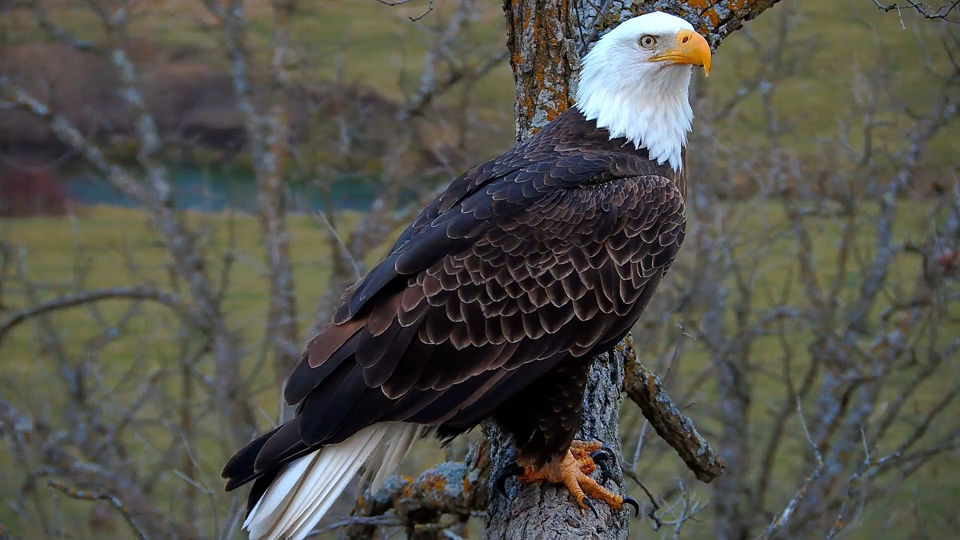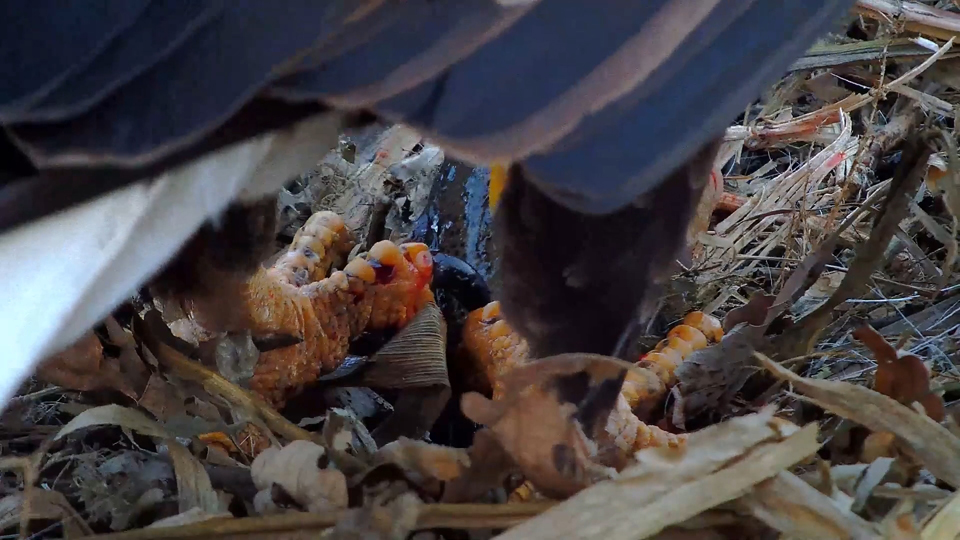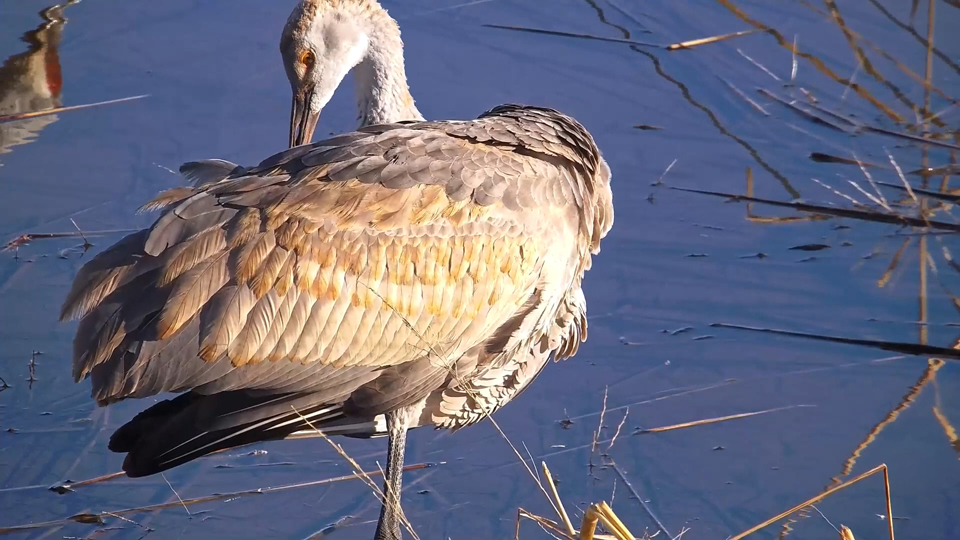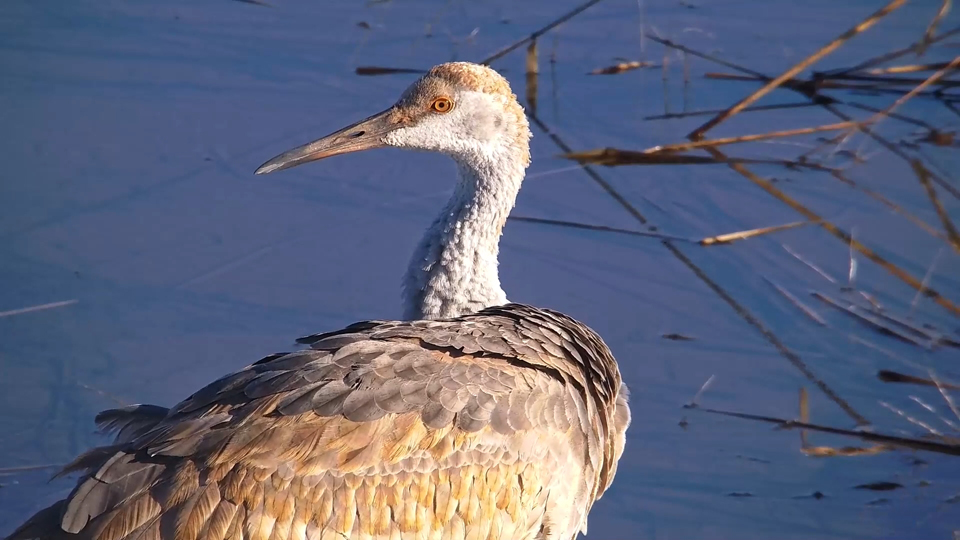It was a busy weekend at the North nest! While us human types sought a little R&R, Mr. North and DNF were hard at work fishing, fixing up the nest, and copulating. We also saw a number of visitors, including a vividly-colored house finch, several woodpeckers, and some juncos. While we were looking, Mr. North was listening, but whatever he was hunting managed to escape through the underbrush! Meanwhile, cranes and bald eagles had watchers agog on the Mississippi Flyway!
I loved all of these videos, but I especially enjoyed the North’s eating fish, Mr. North’s interesting ground pursuit of unseen potential prey, the lovely house finches, and the very cool juvenile sandhill crane in a molt stage we don’t often get to see this close! Thanks to our awesome camera operators and videomakers for finding and preserving such special moments, and to you for watching, sharing, learning, and especially for caring!
Decorah North Eagles
 December 8, 2023: I loved this beautiful portrait of Mr. North!
December 8, 2023: I loved this beautiful portrait of Mr. North!
December 9, 2023: First copulation on cam this season! https://youtu.be/nzDLBVr6fco?si=elxi6ZcTU-62RBGb. It’s pretty hard to see, but look to the farthest tree limbs to the left of the nest at about 43 seconds.
It’s fun to think that the fish acted as an aphrodisiac of sorts and we know that food gifts are an important part of eagle courtship, although we don’t know whether gifting happened here. The relationship between food availability and reproductive behaviors is complex and influenced by various factors, including environmental conditions, habitat quality, and human activities. We’ll blog on that in January.
 December 8, 2023: Mr. North and DNF both feasted on trout today! Rainbow trout are spawning right now.
December 8, 2023: Mr. North and DNF both feasted on trout today! Rainbow trout are spawning right now.
December 8, 2023: The Norths catch fish! Mr.: https://youtu.be/ulGt_gYdpqY?si=OkCqOhRQDHLEp3VQ and DNF: https://youtu.be/Zutf7KRkMeQ?si=ir3PB-Sn7J_-3SQ7. Both Mr. North and DNF brought rainbow trout to the nest this afternoon! Rainbow, brown, and brook trout spawning seasons are in full swing from November through late January, depending on the species. Spawning takes place over shallow rock beds and spawning fish are generally preoccupied and a little easier to catch. I love that winter spawning overlaps with the period that female eagles are building crucial fat and mineral resources for egg laying. Iowans have worked hard to clean up and improve trout streams for fishing, but their work benefits many other animals as well.
December 8, 2023: DNF and Mr. North Nestorations plus visitors – https://youtu.be/jWr3b-nK1WE?si=HZN6Kn0k3uuGNgTj. I thought the most interesting part of this video began at 9:55. Mr. North is perched on a low limb on the pasture tree, appearing to look over the pasture. At 9:59, he plunges down to land on the ground below the tree. We hear but don’t see something scurry away! He begins walking around the thicket at the base of the tree, occasionally stopping to peer in and perhaps test the thicket’s boundaries. He eventually hop-flaps up to a low perch, before preening and flying out to perch on an oak tree upstream of the nest. Look just behind him and you’ll see the multiflora thicket featured in the video just below. This video also has nice closeups of both Norths and North nestorations beginning at 15:18.
In his book ‘The Bald Eagle‘, Mark Stahlmaster identifies five common methods of bald eagle hunting: hunting in flight, hunting from a perch, wading in water, hunting on the ground, and cooperative hunting. While bald eagles prefer fish and we most commonly see them hunting from the air or hunting from a perch, we’ve also seen Mr. North wading in the water and hunting on the ground. Like golden eagles, bald eagles tailor their hunting techniques to suit the terrain, conditions, and prey they are hunting.
December 8, 2023: Beautiful House Finch Feeding – https://youtu.be/kQpNY4Yefis?si=z7jnr1AZR4CeOWDE. This is a lovely video! It opens with a close-up of a finch on a log near the North nest. At :09, we see two finches in a multiflora thicket resplendent with vibrant red berries. At 25 seconds, we get close-ups of the male eating. We can hear his beak clacking together while jays and other birds vocalize in the background. After he flies out, a female finch flies in.
I dread multiflora rose. The wickedly sharp, curved thorns draw blood and rip clothing, and the plant reproduces sexually and clonally, so it spreads easily and abundantly. It was introduced to the U.S. from Japan in 1866 as rootstock for grafted ornamental rose cultivars. In the 1930s, its use was further encouraged by the newly formed U.S. Soil Conservation Service for use in erosion control and as living fences, or natural hedges, to confine livestock. As you might know, the dustbowl of the 1930s brought erosion and soil conservation to the fore: https://www.history.com/topics/great-depression/dust-bowl.
Having said that, many small birds eat multiflora berries and its nearly impenetrable thicket provides excellent protective habitat. We cut it back near the north nest because we literally couldn’t work there if we didn’t. But I always try to leave a few plants for passerine birds. The hill behind the North nests sometimes puts me in mind of an exploratory plant lab for everything cattle don’t eat and people can’t walk through: multiflora rose, raspberry cane, thistles, green briar, gooseberry, and hemp, just to name a few. But passerine birds love the seeds and fruit these plants produce!
Mississippi Flyway
 December 7, 2023: I love the variable and individually unique patterns of rust and gray in this juvenile sandhill’s formative plumage!
December 7, 2023: I love the variable and individually unique patterns of rust and gray in this juvenile sandhill’s formative plumage!
December 7, 2023: Juvenile Sandhill Crane Preening – https://youtu.be/uUaFcJrFpXI?si=ejNuXroIDpe5QEfr. I loved this look at a juvenile sandhill crane in what I believe is its formative plumage! After natal down, cranes have a first basic plumage (July to November) followed by a formative plumage: an intermediate state between first and second basic plumage that results in variable and individually unique patterns of rust and gray. The patterns are visible throughout much of the video, but we get especially great looks at them in the second minute!
Take a look at the crane’s amber eye and yellowish or ochraceous head, which still sports some feathers, but also shows signs of crane-pattern baldness. The iris color changes from amber to orange in a crane’s first year and head feathers recede to bare skin by two to three years of age. A crane’s red, bald head indicates that it is sexually mature, which typically happens at around two or three years of age. A super-cute fact: Crane family units are typically composed of a breeding pair, their most recent offspring, frequently their 2-year-olds, and sometimes much older offspring from previous broods. So this crane is most likely migrating with parents and siblings. Good luck, everybody! We’ll see you next spring.
 December 7, 2023: This crane’s eye will be orange by the end of its first year.
December 7, 2023: This crane’s eye will be orange by the end of its first year.
 The Raptor Resource Project
The Raptor Resource Project The Raptor Resource Project
The Raptor Resource Project